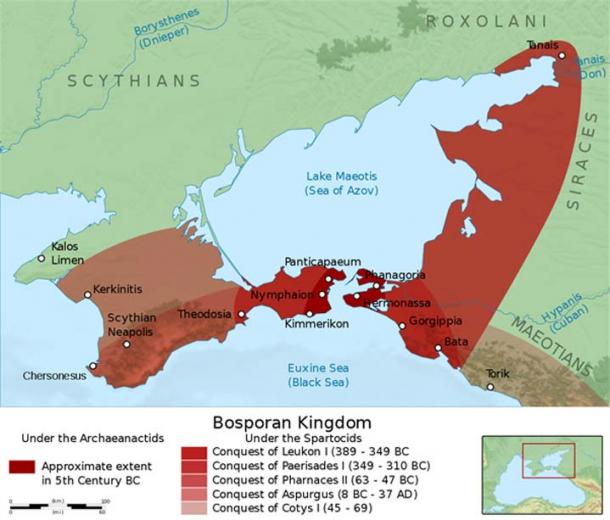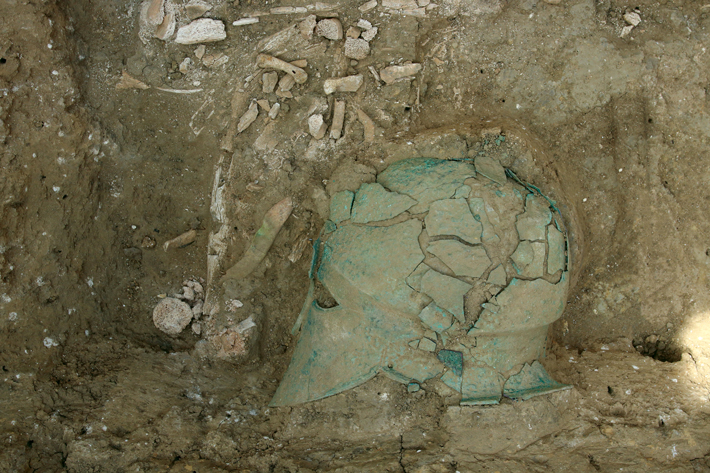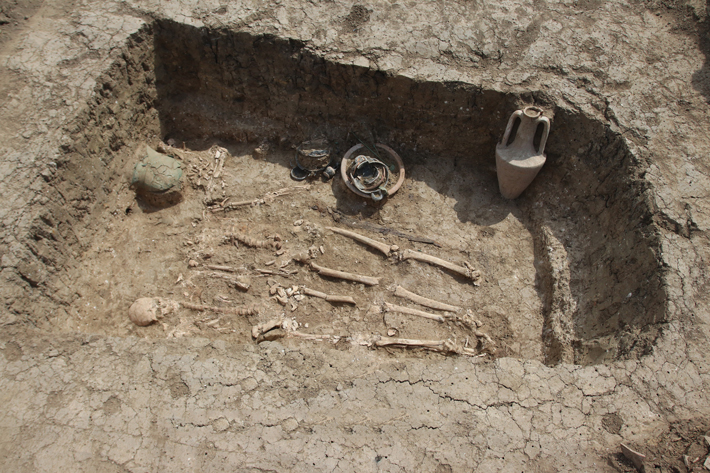It looks like you're using an Ad Blocker.
Please white-list or disable AboveTopSecret.com in your ad-blocking tool.
Thank you.
Some features of ATS will be disabled while you continue to use an ad-blocker.
27
share:
It never dawned on me that the Greeks would have reached up into the Black Sea are or further...
but then again, why wouldn't they?
Ancient Origins
Archaeology.org



but then again, why wouldn't they?
The Russian RIA news agency has reported a remarkable find of an ancient Greek Corinthian helmet. The discovery was made in the Taman Peninsula in the southwest of Russia. The helmet was unearthed during the excavation of a Greek necropolis in the area by the Institute of Archaeology of the Russian Academy of Sciences (IA RAS). The helmet is one of the most remarkable discoveries yet made at this site. The helmet now raises questions as to the nature of Greek society in the ancient Black Sea area and its contacts with the wider Greek world.
Ancient Origins
Archaeology.org



a reply to: LedermanStudio
This is quite the find. Beautiful artifact. I've been watching this series called 'Civilizations', which has really opened my eyes to the rise and fall (and blending) of ancient civilizations.
Very cool news - thank you for sharing!
This is quite the find. Beautiful artifact. I've been watching this series called 'Civilizations', which has really opened my eyes to the rise and fall (and blending) of ancient civilizations.
Very cool news - thank you for sharing!
a reply to: LedermanStudio
Alexander established a town in modern Afghanistan. Greek colonies all over the Black Sea region, on all sides. If you think of the Golden Fleece, then Colchis (where it was kept) is modern day Georgia. Promotheus was chained in the Caucusus mountains. The Island of Achilles is in the Black Sea.
Really cool find. Thanks for sharing
Alexander established a town in modern Afghanistan. Greek colonies all over the Black Sea region, on all sides. If you think of the Golden Fleece, then Colchis (where it was kept) is modern day Georgia. Promotheus was chained in the Caucusus mountains. The Island of Achilles is in the Black Sea.
Really cool find. Thanks for sharing
a reply to: LedermanStudio
Thanks for posting. I read Ancient Origins and didn't even notice this.
It doesn't surprise me much as I believe in diffusionist theories about trade and the Greeks were pretty active. What does surprise me is that there is only one. I guess the Russians in that area were latecomers to the world trade game.
I think back in those days, the silk road only went to India. It probably went further but Europe didn't seem to know much about it.
Thanks for posting. I read Ancient Origins and didn't even notice this.
It doesn't surprise me much as I believe in diffusionist theories about trade and the Greeks were pretty active. What does surprise me is that there is only one. I guess the Russians in that area were latecomers to the world trade game.
I think back in those days, the silk road only went to India. It probably went further but Europe didn't seem to know much about it.
a reply to: LedermanStudio
Trade routes can't be overlooked. It's really extraordinary how stuff got around and not just during the classical Greek period, but centuries earlier.
A stone hand axe was found in Southern England that was carved from jadeite in the Austrian alps some 6000 years ago. People had only just started riding horses instead of eating them. Imagine what 800 miles looked like back then and how the heck the axe made its way there and how many owners traded it. www.bbc.co.uk...
Another example is one of the Irish 'bog bodies' used Spanish tree sap as hair gel. Picture a dude from 3000 years ago with an Elvis quiff. Somehow something as niche as hair gel had a market and was traded from Spain to the NW of Ireland. www.nationalgeographic.com...
The popular picture of 'ancient times' is that Russia through Europe was a fragmented mass of territories occupied by warring tribes. We imagine it'd be impossible to go 100 miles without being robbed or killed for being a foreigner. In reality, merchants followed trade routes and objects could be passed along from one person to another and cross hundreds of miles. It doesn't necessarily mean Trader Joe himself travelled the breadth of the European land mass, but goods could pass through regions like the old image of people passing buckets of water along a chain to put a fire out.
Trade routes can't be overlooked. It's really extraordinary how stuff got around and not just during the classical Greek period, but centuries earlier.
A stone hand axe was found in Southern England that was carved from jadeite in the Austrian alps some 6000 years ago. People had only just started riding horses instead of eating them. Imagine what 800 miles looked like back then and how the heck the axe made its way there and how many owners traded it. www.bbc.co.uk...
Another example is one of the Irish 'bog bodies' used Spanish tree sap as hair gel. Picture a dude from 3000 years ago with an Elvis quiff. Somehow something as niche as hair gel had a market and was traded from Spain to the NW of Ireland. www.nationalgeographic.com...
The popular picture of 'ancient times' is that Russia through Europe was a fragmented mass of territories occupied by warring tribes. We imagine it'd be impossible to go 100 miles without being robbed or killed for being a foreigner. In reality, merchants followed trade routes and objects could be passed along from one person to another and cross hundreds of miles. It doesn't necessarily mean Trader Joe himself travelled the breadth of the European land mass, but goods could pass through regions like the old image of people passing buckets of water along a chain to put a fire out.
originally posted by: Kandinsky
a reply to: LedermanStudio
Trade routes can't be overlooked. It's really extraordinary how stuff got around and not just during the classical Greek period, but centuries earlier.
A stone hand axe was found in Southern England that was carved from jadeite in the Austrian alps some 6000 years ago. People had only just started riding horses instead of eating them. Imagine what 800 miles looked like back then and how the heck the axe made its way there and how many owners traded it. www.bbc.co.uk...
Another example is one of the Irish 'bog bodies' used Spanish tree sap as hair gel. Picture a dude from 3000 years ago with an Elvis quiff. Somehow something as niche as hair gel had a market and was traded from Spain to the NW of Ireland. www.nationalgeographic.com...
The popular picture of 'ancient times' is that Russia through Europe was a fragmented mass of territories occupied by warring tribes. We imagine it'd be impossible to go 100 miles without being robbed or killed for being a foreigner. In reality, merchants followed trade routes and objects could be passed along from one person to another and cross hundreds of miles. It doesn't necessarily mean Trader Joe himself travelled the breadth of the European land mass, but goods could pass through regions like the old image of people passing buckets of water along a chain to put a fire out.
Thank you sincerely for this reply. I'm going to dig in
originally posted by: Kandinsky
a reply to: LedermanStudio
Trade routes can't be overlooked. It's really extraordinary how stuff got around and not just during the classical Greek period, but centuries earlier.
A stone hand axe was found in Southern England that was carved from jadeite in the Austrian alps some 6000 years ago. People had only just started riding horses instead of eating them. Imagine what 800 miles looked like back then and how the heck the axe made its way there and how many owners traded it. www.bbc.co.uk...
Another example is one of the Irish 'bog bodies' used Spanish tree sap as hair gel. Picture a dude from 3000 years ago with an Elvis quiff. Somehow something as niche as hair gel had a market and was traded from Spain to the NW of Ireland. www.nationalgeographic.com...
The popular picture of 'ancient times' is that Russia through Europe was a fragmented mass of territories occupied by warring tribes. We imagine it'd be impossible to go 100 miles without being robbed or killed for being a foreigner. In reality, merchants followed trade routes and objects could be passed along from one person to another and cross hundreds of miles. It doesn't necessarily mean Trader Joe himself travelled the breadth of the European land mass, but goods could pass through regions like the old image of people passing buckets of water along a chain to put a fire out.
Very cool find. One other comment the population density was very low at that time - lots of Europe was empty Territory.
originally posted by: Hanslune
originally posted by: Kandinsky
a reply to: LedermanStudio
Trade routes can't be overlooked. It's really extraordinary how stuff got around and not just during the classical Greek period, but centuries earlier.
A stone hand axe was found in Southern England that was carved from jadeite in the Austrian alps some 6000 years ago. People had only just started riding horses instead of eating them. Imagine what 800 miles looked like back then and how the heck the axe made its way there and how many owners traded it. www.bbc.co.uk...
Another example is one of the Irish 'bog bodies' used Spanish tree sap as hair gel. Picture a dude from 3000 years ago with an Elvis quiff. Somehow something as niche as hair gel had a market and was traded from Spain to the NW of Ireland. www.nationalgeographic.com...
The popular picture of 'ancient times' is that Russia through Europe was a fragmented mass of territories occupied by warring tribes. We imagine it'd be impossible to go 100 miles without being robbed or killed for being a foreigner. In reality, merchants followed trade routes and objects could be passed along from one person to another and cross hundreds of miles. It doesn't necessarily mean Trader Joe himself travelled the breadth of the European land mass, but goods could pass through regions like the old image of people passing buckets of water along a chain to put a fire out.
Very cool find. One other comment the population density was very low at that time - lots of Europe was empty Territory.
Thanks Hans and it's always good to see you.
a reply to: LedermanStudio
You're most welcome. Awe for the past is a great feeling.
The jade axe link isn't working, try this one here if you're still interested. There's a DL link for a 12 minute discussion on it. If you want it and can't get it send a PM.
Here's one of the earlier shows from YT.
a reply to: Kandinsky
And a lot of things probably were transferred across landmasses from things such as Alexander the Great and his merry band of travellers, Roman Armies, etc, roaming the land, trading, taking things from people they conquered in foreign lands, being killed and buried with those things in yet another far off land, a grave robber takes it and it goes off in another direction, that grave robber is fatally bashed in the head with mace by a whore who takes what valuables he has and manages to grow old and pass it to her children and it remains a family heirloom for over 3 centuries until one day crackhead Charlie steals it from his aunt's house and takes it to the pawnshop or otherwise sells or trades it away.
What I mean is yeah there was massive amounts of peaceful trade going on, but also a lot of "unpeaceful" trade that likely transferred things "chaotically" from one place to another and wars were constant back then.
And a lot of things probably were transferred across landmasses from things such as Alexander the Great and his merry band of travellers, Roman Armies, etc, roaming the land, trading, taking things from people they conquered in foreign lands, being killed and buried with those things in yet another far off land, a grave robber takes it and it goes off in another direction, that grave robber is fatally bashed in the head with mace by a whore who takes what valuables he has and manages to grow old and pass it to her children and it remains a family heirloom for over 3 centuries until one day crackhead Charlie steals it from his aunt's house and takes it to the pawnshop or otherwise sells or trades it away.
What I mean is yeah there was massive amounts of peaceful trade going on, but also a lot of "unpeaceful" trade that likely transferred things "chaotically" from one place to another and wars were constant back then.
a reply to: 3n19m470
Absolutely. I was in the Imperial War Museum recently and there were lots of trophies taken by British soldiers on display. It's always been standard for the dead to be looted for valuables.
Also not many people think about weapons, shields and helmets and how important they were. People today wouldn't leave a loaded firearm lying around in case an enemy got it. Same back then. Breaking weapons and shields etc stopped the enemy reusing them or rearming the population. Obviously the good stuff would be kept for its value or potential use and those helmets were beautiful.
Absolutely. I was in the Imperial War Museum recently and there were lots of trophies taken by British soldiers on display. It's always been standard for the dead to be looted for valuables.
Also not many people think about weapons, shields and helmets and how important they were. People today wouldn't leave a loaded firearm lying around in case an enemy got it. Same back then. Breaking weapons and shields etc stopped the enemy reusing them or rearming the population. Obviously the good stuff would be kept for its value or potential use and those helmets were beautiful.
a reply to: LedermanStudio
There was quite a bit of trading going between countrys in old days,I don't see why it would be obscure,sure many a Greek set foot on Russia
There was quite a bit of trading going between countrys in old days,I don't see why it would be obscure,sure many a Greek set foot on Russia
a reply to: LedermanStudio
They went to the Crimea to buy grain. It was one of the great food stores of the Greek world, once their population expanded.
The trade route even gets into legend- Jason and the Argonauts. There's also a case that the Trojan war was really about control of access to the Black Sea.
They went to the Crimea to buy grain. It was one of the great food stores of the Greek world, once their population expanded.
The trade route even gets into legend- Jason and the Argonauts. There's also a case that the Trojan war was really about control of access to the Black Sea.
edit on 30-10-2018 by DISRAELI because: (no reason given)
a reply to: LedermanStudio
Seeing as you are interested in this topic, here is a bit of additional information about Greek Colonization (it is only the last section that is particularly about the Black Sea Region).
Seeing as you are interested in this topic, here is a bit of additional information about Greek Colonization (it is only the last section that is particularly about the Black Sea Region).
new topics
-
Azerbaijan E190 Passenger Jet Shot Down by Russia
Mainstream News: 1 hours ago -
Orange County Makes Shoplifting a Felony
Other Current Events: 5 hours ago -
It's Offical Now
US Political Madness: 8 hours ago -
The reason it works is.....
General Chit Chat: 8 hours ago -
Dick Van Dyke saved from Wildfire by neighbours on his 99th birthday
People: 11 hours ago
top topics
-
Orange County Makes Shoplifting a Felony
Other Current Events: 5 hours ago, 13 flags -
It's Offical Now
US Political Madness: 8 hours ago, 11 flags -
The reason it works is.....
General Chit Chat: 8 hours ago, 7 flags -
Dick Van Dyke saved from Wildfire by neighbours on his 99th birthday
People: 11 hours ago, 5 flags -
Azerbaijan E190 Passenger Jet Shot Down by Russia
Mainstream News: 1 hours ago, 4 flags
active topics
-
This is an interesting picture. Do we actually pick our leaders?
Politicians & People • 12 • : angelchemuel -
Azerbaijan E190 Passenger Jet Shot Down by Russia
Mainstream News • 7 • : Springbok -
Petition Calling for General Election at 564,016 and rising Fast
Political Issues • 165 • : angelchemuel -
Merry Christmas !!
General Chit Chat • 18 • : angelchemuel -
Mood Music Part VI
Music • 3764 • : Hellmutt -
Orange County Makes Shoplifting a Felony
Other Current Events • 19 • : Coelacanth55 -
It's Offical Now
US Political Madness • 10 • : rickymouse -
The Acronym Game .. Pt.4
General Chit Chat • 1027 • : FullHeathen -
NYPD arrests migrant who allegedly set woman on fire on subway train, watched her burn to death
Breaking Alternative News • 54 • : Irishhaf -
Christmas Dinner ??
Food and Cooking • 18 • : network dude
27
